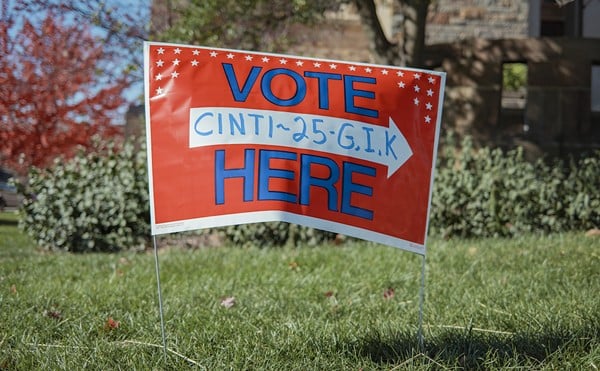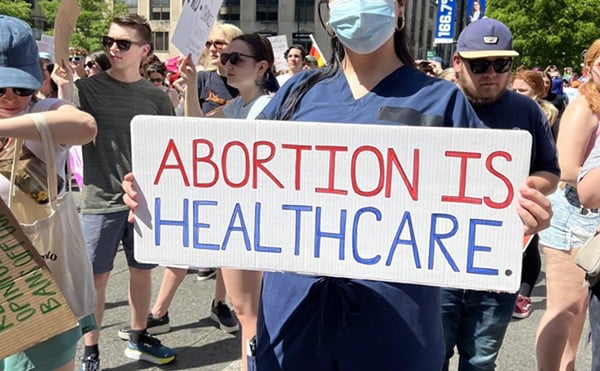|
What do they want? Justice. When do they want it? Now. Where the heck are they headed? That's not always clear.
Sometimes the protesters on Cincinnati streets the past five weeks follow a leader, and other times they wander without apparent direction. Events last week demonstrated both the strength and the weakness of the movement that coalesced after the fatal April 7 police shooting of Timothy Thomas.
Chanting reverberated through downtown May 8 as protesters led by Rev. Damon Lynch III occupied a restaurant and marched to City Hall. In between, acting without a permit, the 60 or so protesters achieved something they'd been denied by police in the days after Thomas' death: They rallied on Fountain Square.
The protesters were able to spread their message not just within the neighborhood where the shooting took place but to business people and shoppers downtown as well.
The crowd's message was considerably louder than its size would suggest. A day after the impromptu march, Cincinnati Arts Festival, Inc. canceled Pepsi Jammin' on Main, the annual street festival, exactly as Lynch's movement, the Black United Front, had demanded.
But if the march on City Hall proved the protesters have Cincinnati's attention, it also showed they sometimes don't know what to do with it. Fresh from having forced the cancellation of Jammin' on Main, Lynch seemed to call for cancellation of the next major downtown festival, Taste of Cincinnati. But his remarks caused such an uproar that Lynch then appeared to back away from the demand.
The Black United Front formed after downtown restaurants closed during last summer's Ujima Cinci-bration, a festival of African-American heritage. The organization is a loosely structured body whose goals have sometimes been hard to ascertain.
Last year, for example, the Black United Front called for a boycott of Cincinnati, only to have its spokesmen later withdraw the idea. Efforts to obtain a definitive position from the Black United Front can be a frustrating exercise, with various leaders giving conflicting answers.
The protests that began last month have occasionally been short on direction, but spontaneity is not without value, and some of the people taking to the streets are getting their first taste of political activism.
Stay awake
Brandon Hill, 18, was at Fountain Square to protest May 8.
"We want to stop racism," says Hill, a student at Northern Kentucky University, where he is president of Students Together Against Racism. "It's about freedom and equality."
Robert Pace, chairman of the Black Youth Movement and co-chair of the Political Action Committee of the Black United Front, smiled last week as he watched the crowd on Fountain Square.
"We've been trying to get people to protest like this for years," Pace says. "Now that they're awakened, we don't want them to go back to sleep."
George Beatty, who protested as a high school student in the 1960s, went to watch the protest. Beatty says protests can be successful with or without a designated leader.
"Why do you need organization?" he says. "Sometimes out of disorganization comes organization. These people feel the passion. They don't need to be led."
The core issue in Cincinnati, according to Beatty, isn't a matter of black vs. white.
"It's good vs. evil," he says.
April 14, the day Thomas was buried, might have been a turning point for the culture of protest in Cincinnati. Terry Coleman of Price Hill went to Over-the-Rhine that day, holding a sign outside Thomas' funeral that read, "Stop Killing Us, We Also Have to Respect Ourselves."
Coleman says police shot him with "beanbags" as he walked with a peaceful crowd, but he says he won't be discouraged from going out again.
"Protesting is a way to convey my message on how I feel when I feel something is wrong," Coleman says.
He believes human rights are worth defending.
"I believe in people," he says.
Coleman is one of more than two dozen people who have filed suit against the city over police violence against protesters. The plaintiffs say they were maced, shot with non-lethal ammunition, detained without reason, handcuffed and struck with billy clubs. Those complaints are the subject of an investigation by the U.S. Department of Justice, including evidence pending before a federal grand jury.
The city has been repeatedly socked with lawsuits this year, including one accusing police of racial profiling. Attorney Kenneth Lawson last week filed suit against the city on behalf of Thomas' mother, Angela Leisure. He has also filed suit on behalf of two children shot with "beanbags" by police in the same incident in which Coleman was shot.
The children — two girls, ages 7 and 11 — weren't attending Thomas' funeral but were going with their families to pick up barbecue. The suit claims the girls were separated from their parents in the "mayhem and panic" caused by officers "sadistically firing into the peaceful crowd."
Both girls are now receiving mental health care, afraid of police and afraid of going downtown, Lawson says.
"If you do this in broad daylight when the whole world is watching, what will you do at night when no one is watching?" he says.
The officers who shot the children weren't rookies, but members of the police division's SWAT team.
"It would be different if you're Barney Fife and you don't know how to shoot," Lawson says.
He says officers should have questioned orders to shoot into the crowd.
"There's no way in hell you can give me an order to drive in and open fire on innocent people," Lawson says.
Mike Harmon, a civil litigator for the city solicitor's office, says lawsuits have limited usefulness in ending social divisions.
"Lawsuits don't heal people, no matter who wins," Harmon says. "If we're going to learn to love each other and care about each other, it's going to take more than a lawsuit."
Love and care might come down the road. But for now protesters and their lawyers want changes in police conduct. The lawsuits will help, according to Lawson.
"I think it's going to have an impact, but I think the racial profiling suit is going to have the biggest impact with respect to structural change," he says.
Frederick T. Suggs Sr., deacon at Bethlehem Baptist Church in Avondale, was in Cincinnati during protests and riots in 1967 and 1968. He observed the group that marched to City Hall on May 8.
"The difference between now and '68 is you have a wider gap between the police and the community than it was then," Suggs says. "It's healing time. There are a lot of mechanisms in place that have to be changed, but it's going to take time to change them."
Stop or I'll sue
Complaints about the police shooting of the little girls and lawsuits by Coleman and others seem to have had an effect. Police presence was heavy on the streets in the week after Thomas' death, with officers in riot gear hemming in demonstrations in Over-the-Rhine.
By contrast, when Officer Stephen Roach's indictment for killing Thomas was announced May 7, police stayed out of sight of crowds in front of the prosecutor's office. When the crowd started marching up Main Street, officers followed but hung back.
The scene stayed relatively peaceful — and relatively disorganized. No one gave a speech, no one chanted. The crowd meandered its way through Over-the-Rhine until it arrived at Lynch's church.
Police also maintained their distance the next day, May 8, when protesters took over a downtown bar, rallied on Fountain Square and walked through the streets to City Hall. Lynch told reporters he wanted to disrupt "business as usual."
Protesters occupied the Fifth & Vine Street Bar at lunchtime, holding signs and staying for about 30 minutes. Some diners left, while others stayed to finish their food.
Wayne Boddington, general manager of the bar, calmly stood outside, apparently not distressed by the brief occupation. Boddington said he didn't know why protesters chose his bar for the sit-in, but he didn't mind.
"It's a protest of sorts and we understand the emotions," Boddington said May 8. "It's been a very peaceful kind of demonstration and protest."
On reaching City Hall, the protesters were more orderly than the crowd that took over council chambers two days after Thomas' death. This time protesters filled out cards seeking permission to speak, took turns and remained fairly quiet when others spoke.
Some speakers claimed they had been harassed and brutalized by police in their neighborhoods. Others voiced outrage at Roach's indictment for negligent homicide and obstructing official business, each charge a misdemeanor.
City Councilman Paul Booth wouldn't tell the crowd his thoughts about the indictment.
"None of us are privy to all the facts right now," Booth said.
Meanwhile, small victories are occurring on the streets. Despite fears that protests Friday would disrupt a memorial march to honor slain police officers, the Black United Front is urging respect. Rev. William Land, chairman of the political and social action demonstration committee of the Black United Front, says the group has no intentions of protesting at the march.
"We think everyone has the right to bury their dead and honor their dead," Land says.
Police, too, appear to be reevaluating their strategy.
"We're a constant learning organization," says Lt. Colonel Richard Janke.
Do officers feel mistreated by criticism?
"Police officers work within the justice system every day of their lives," Janke says. "They understand the process."
Janke was one of several officers near council chambers as the protesters spoke with Booth and other council members May 8. The protesters, he said, were "exercising democracy."
If that attitude seems a change from one month earlier, the protests — no matter how disorganized — have already yielded positive results. ©





